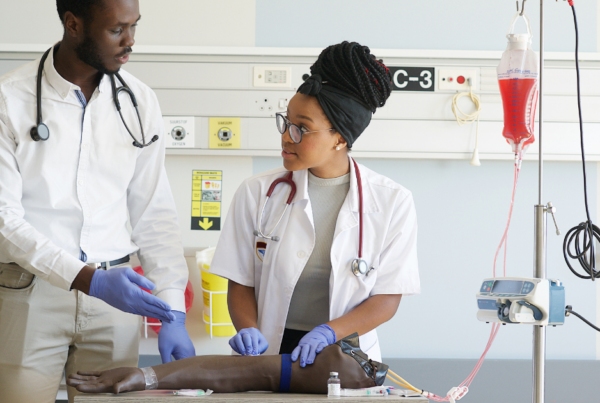If you’re considering a career in healthcare but want to enter the field quickly, becoming a phlebotomist is an excellent option. One of the first questions aspiring phlebotomists ask is, “What is the starting pay for a phlebotomist?” The answer varies based on experience, location, and workplace setting. This guide will break down starting salaries, factors that influence pay, ways to increase your earning potential, and the long-term benefits of a phlebotomy career. Additionally, we’ll explore the job outlook, common benefits, and why phlebotomy remains a reliable career choice in the medical field.
| Key Takeaways: What Is the Starting Pay for a Phlebotomist? |
| Entry-level phlebotomists earn $14-$17 per hour depending on location, employer, and certification. |
| Salaries increase with experience, with late-career phlebotomists earning nearly $20 per hour. |
| High-paying locations include California, Washington, and New York. |
| Certification, experience, and working in specialized healthcare settings can increase earning potential. |
| Advancing into supervisory roles or furthering education can lead to higher salaries. |
What Is a Phlebotomist?
A phlebotomist is a healthcare professional trained to draw blood for medical testing, transfusions, research, and donations. They play a crucial role in patient care, ensuring samples are collected safely and accurately. Their duties include verifying patient identities, preparing blood samples for analysis, maintaining sterile equipment, and keeping detailed records. Phlebotomists work in various settings, including hospitals, diagnostic labs, blood donation centers, outpatient clinics, and research facilities. Many phlebotomists also provide emotional support to patients who are nervous about having blood drawn, making their role an essential part of the healthcare team.
What Is the Starting Pay for a Phlebotomist?
According to the U.S. Bureau of Labor Statistics (BLS), the average salary for a phlebotomist is $41,810 per year or $20.10 per hour. However, entry-level phlebotomists typically earn between $14 and $17 per hour, depending on their location, employer, and level of certification. While these numbers represent national averages, some regions offer significantly higher wages due to increased demand and cost of living.
Factors Affecting Entry-Level Phlebotomy Salaries
Several factors determine the starting pay for a phlebotomist, including geographic location, workplace setting, experience level, and additional certifications. Understanding these factors can help new phlebotomists maximize their earning potential early in their careers.
Geographic Location
Phlebotomists in certain states earn significantly higher wages due to demand and cost of living. For example:
- California – $52,370 per year
- Washington – $50,800 per year
- New York – $50,110 per year
In contrast, states like Mississippi and Louisiana offer lower wages, with salaries averaging around $33,000 to $35,000 per year. Metropolitan areas tend to pay more than rural regions due to higher demand and living costs. Large cities with a high concentration of medical facilities often have more job openings and opportunities for advancement.
Type of Workplace
Where you work significantly impacts how much you earn as a phlebotomist. According to the BLS:
- Outpatient Care Centers – $46,130 per year
- Medical and Diagnostic Labs – $45,100 per year
- Hospitals – $39,920 per year
- Physician Offices – $39,800 per year
- Ambulatory Healthcare Services – $37,750 per year
Phlebotomists working in specialty medical labs or high-demand research facilities may receive additional incentives, such as performance bonuses or shift differentials for working nights or weekends.
Experience Level
While entry-level phlebotomists earn around $14-$17 per hour, salaries increase with experience and specialization:
- Entry-Level (0-1 year) – $14.42 per hour
- Early Career (1-4 years) – $15.28 per hour
- Mid-Career (5-9 years) – $16.86 per hour
- Experienced (10-19 years) – $18.18 per hour
- Late Career (20+ years) – $19.34 per hour
With experience, phlebotomists may transition into supervisory or managerial roles, leading to further salary increases and job security.
Additional Certifications and Specializations
Becoming certified through organizations such as the American Society for Clinical Pathology (ASCP), National Healthcareer Association (NHA), or American Medical Technologists (AMT) can improve job prospects and earning potential. Specialized training in pediatric or geriatric phlebotomy can also result in higher wages. Advanced certifications may lead to roles in laboratory technology or phlebotomy instruction.
How to Increase Your Phlebotomy Salary
If you’re looking to boost your earning potential as a phlebotomist, consider the following strategies:
Get Certified
Although certification isn’t required in every state, becoming a certified phlebotomy technician (CPT) can help you secure higher-paying jobs. Certification programs are available through multiple professional organizations and can give you a competitive edge in the job market. Employers often prefer certified candidates due to their verified skills and training.
Gain Experience in High-Demand Settings
Most phlebotomists start at entry-level salaries, but as you gain experience, your earning potential increases. Look for opportunities to practice in high-demand environments such as emergency rooms, trauma centers, or specialized diagnostic labs. These settings often provide more learning experiences and higher pay.
Specialize in a High-Paying Setting
Some workplaces offer better compensation than others. Consider applying for positions in diagnostic laboratories, outpatient care centers, or major metropolitan hospitals where salaries tend to be higher. Employers in specialized research facilities or private healthcare institutions may also offer higher wages and better benefits. Working in blood banks or mobile phlebotomy services can also provide additional income opportunities.
Consider Relocation
If you’re open to moving, consider working in a state or city with higher salaries. For example, San Jose, CA and San Francisco, CA offer phlebotomists over $59,000 per year. Researching areas with high demand for phlebotomists can help you find better-paying opportunities. Relocation assistance may be available for certain hospital or laboratory positions.
Advance Your Career
Many phlebotomists use their experience as a stepping stone to other healthcare careers. Some pursue additional certifications or further education in nursing, medical assisting, or laboratory technology, which can lead to higher-paying roles. Becoming a phlebotomy instructor or supervisor is another way to boost your income. Professional development and continuing education courses can also open doors to leadership roles within the healthcare industry.
Is Phlebotomy a Good Career Choice?
Phlebotomy offers job stability, quick entry into the healthcare field, and opportunities for growth. With an 8% job growth projection from 2023-2033, there is a strong demand for skilled phlebotomists nationwide. The role provides valuable hands-on experience in patient care, making it an excellent stepping stone for those considering careers in healthcare. The field also offers flexible scheduling options, making it a great choice for individuals looking for work-life balance.
If you’re looking for a healthcare career with competitive starting pay, phlebotomy is an excellent choice. Whether you’re just starting out or looking to advance, there are many ways to increase your salary and build a long-term career in the medical field. Many employers also offer benefits such as healthcare coverage, retirement plans, and tuition reimbursement for further education.
FAQs: What Is the Starting Pay for a Phlebotomist?
What is the lowest starting salary for a phlebotomist?
The lowest starting salary is around $14 per hour, depending on the state and employer.
Do certified phlebotomists make more money?
Yes, certified phlebotomists generally earn higher salaries than non-certified professionals.
Can phlebotomists work in hospitals?
Yes, hospitals employ a large number of phlebotomists for inpatient and outpatient services.
How much time is required to become a phlebotomist?
Most phlebotomy programs take between 4-9 months to complete.
Is phlebotomy a good career choice?
Yes, it’s an in-demand profession with good job stability and opportunities for growth.
How can a phlebotomist increase their salary?
By gaining experience, obtaining certification, working per diem, or taking on supervisory roles.
Which states pay phlebotomists the most?
California, Washington, and New York offer the highest salaries.
Are there opportunities to advance in phlebotomy?
Yes, you can become a phlebotomy supervisor, instructor, or advance into nursing.
Do phlebotomists get benefits?
Most full-time phlebotomists receive healthcare, retirement, and paid time off benefits.
Is phlebotomy stressful?
It can be, but strong communication skills and experience help manage stress effectively.
Conclusion
Phlebotomy is a rewarding career that provides job stability, a relatively quick entry into the healthcare field, and opportunities for professional growth. While the starting pay ranges from $14 to $18 per hour, factors like experience, location, and workplace setting can significantly impact earnings. By obtaining certifications, gaining experience, and considering higher-paying locations, phlebotomists can maximize their salary potential. If you’re passionate about patient care and looking for a solid career path, phlebotomy is an excellent choice with a promising future.
Ready to Start Your Phlebotomy Career in Texas?
Phlebotomy Now School offers top-tier training programs to help you launch your healthcare career quickly.
Enroll today and take the first step toward becoming a certified phlebotomist! With comprehensive hands-on training and expert instruction, you’ll be well-prepared to enter the workforce and start earning right away.


